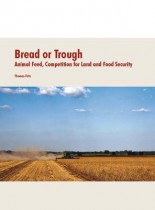
Introduction
While the phenomenon of land grabbing has led to a wider public debate, essential drivers of this trend still remain comparatively underexposed. This is particularly true for land-use changes caused by the growing demand for animalbased products and the associated cultivation of animal feed. The high consumption of animal feed is a result of diets with a high proportion of meat, milk, eggs and other animal products. This type of nutrition uses a large number of resources such as arable land, water and energy and is also very wasteful due to the inefficient conversion of plant energy and proteins into animal-based foods. The risks of this consumption pattern increase with the growing number of people switching to diets with high proportions of animal products. Nevertheless, it still remains a highly unequal consumption model excluding the majority
of the human race. It presumes that not all humans have equal access to the Earth’s natural resources. It is therefore urgent to deal with the continuous boom in animal feed, its drivers and consequences. With this publication, the Centre for Research and Documentation Chile-Latin America (FDCL) aims to contribute to the public debate on this pressing issue. The publication describes how the increasing consumption of meat is encouraging the cultivation of feed crops. It analyses the European Union’s high deficit in animal feeds, particularly with regard to protein-rich crops, as well as its heavy dependence on the imports of soy. It then
outlines the social and ecological impacts of the cultivation of this protein crop in the main supplying countries of South America. The publication also asks to what extent a dietary change reducing the consumption of animal products could contribute to limiting the risks of the excessive demand for animal feed. Finally, it offers a range of recommendations on how animal feed consumption can be reduced in order to mitigate the growing number of land disputes and ensure global food security.
Inhalt
1. Introduction
2. Boom in animal feed
2.1. Move towards intensive livestock systems
2.2. Trough or plate: feeding of cereals
2.3. Animal feed: inefficient and land-consuming
3. EU: animal feed imports and surplus production
3.1. From surplus production to dumping
3.2. The European protein deficit
3.3. Land as a commodity: virtual imports
4. Impacts of soy cultivation in South America
4.1. Environmental destruction: Shrinking forests and pastures
4.2. Land grabbing and rural conflicts
4.3. Lethal cocktail: GMOs and herbicides
5. Benefits of a diet change
5.1. Saving land
5.2. Food security
6. Recommendations
7. References
Impressum
Editor:
Forschungs- und Dokumentationszentrum
Chile-Lateinamerika – FDCL e.V.
Gneisenaustraße 2a, D-10961 Berlin
Fon: +49 30 693 40 29 / Fax: +49 30 692 65 90
eMail: info@fdcl.org / Internet: www.fdcl.org
Author: Thomas Fritz
Publisher: FDCL-Verlag, Berlin
Layout: Monika Brinkmöller
Print: Copy House
Cover photo: big grey mare/flickr.com
This publication has been produced with financial
support from the European Union. The contents of
this publication are the sole responsibility of publishing
organisations and can in no way be taken to reflect
the views of the European Union. This publication is published
within the framework of the EU funded project „Put MDG1 back on
track: supporting small scale farmers, safety nets and stable markets
to achieve food security“. Partners in the project are: Glopolis (CZ),
FDCL (DE), SOS Faim Belgium und SOS Faim Luxembourg.
This text is based on the study “Brot oder Trog – Futtermittel, Flächenkonkurrenz
und Ernährungssicherheit” written by the same author
and jointly published by “Brot für die Welt” and FDCL in 2011.
